Pig
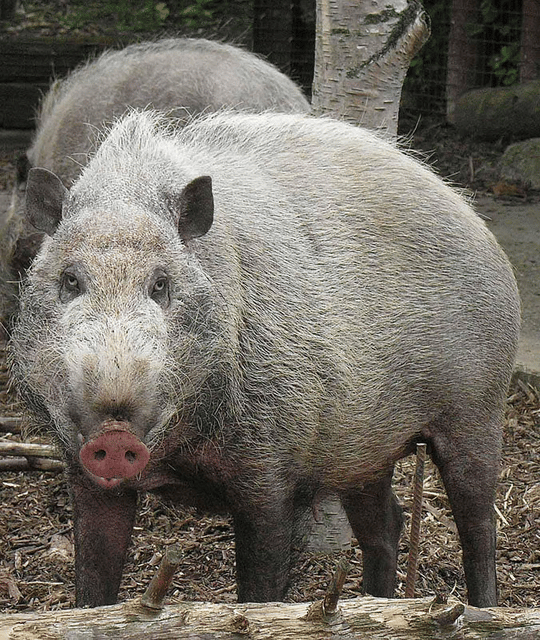
Pig

| Pig | |
|---|---|
| Bornean bearded pigat theLondon Zoo. | |
| Scientific classification | |
| Kingdom: | Animalia |
| Phylum: | Chordata |
| Class: | Mammalia |
| Order: | Artiodactyla |
| Family: | Suidae |
| Subfamily: | Suinae |
| Genus: | Sus ,1758 |
| Species | |
A pig is any of the animals in the genus Sus, within the even-toed ungulate family Suidae. Pigs include the domestic pig and its ancestor, the common Eurasian wild boar (Sus scrofa), along with other species. Related creatures outside the genus include the peccary, the babirusa, and the warthog. Pigs, like all suids, are native to the Eurasian and African continents. Juvenile pigs are known as piglets.[1] Pigs are highly social and intelligent animals.[2]
With around 1 billion individuals alive at any time, the domestic pig is among the most populous large mammals in the world.[3][4] Pigs are omnivores and can consume a wide range of food.[5] Pigs are biologically similar to humans and are thus frequently used for human medical research.[6]
| Pig | |
|---|---|
| Bornean bearded pigat theLondon Zoo. | |
| Scientific classification | |
| Kingdom: | Animalia |
| Phylum: | Chordata |
| Class: | Mammalia |
| Order: | Artiodactyla |
| Family: | Suidae |
| Subfamily: | Suinae |
| Genus: | Sus ,1758 |
| Species | |
Etymology
The Online Etymology Dictionary
probably from Old English picg, found in compounds, ultimate origin unknown. Originally "young pig" (the word for adults was swineLow German biggeDutch big* ("but the phonology is difficult" --* OED).... Another Old English word for "pig" was fearh, related to furh "furrow," from PIE perk- "dig, furrow" (source also of Latin porc-us"pig," see* porkIE tendency to name animals from typical attributes or activities" [Roger Lass]. Synonyms grunter*,* oinker* are from sailors' and fishermen's euphemistic avoidance of uttering the word pig at sea, a superstition perhaps based on the fate of the Gadarene swine, who drowned.[7]
The Online Etymology Dictionary also traces the evolution of sow, the term for a female pig, through various historical languages:
Old English sugu, su "female of the swine," from Proto-Germanic su suGerman SauDutch zeugOld Norse syrPIE root suSanskrit sukarahAvestan huGreek hysLatin sus"swine", suinusOld Church Slavonic svinijaLettish sivensWelsh huccIrish suigOld Irish socc"snout, plowshare"), possibly imitative of pig noise; note that Sanskrit* sukharahmeans "maker of (the sound) su*.[7]
It is entirely likely that the word to call pigs, "soo-ie," is similarly derived.
An adjectival form is porcine. Another adjectival form (technically for the subfamily rather than genus name) is suine (comparable to bovine, canine, etc.); for the family, it is suid (as with bovid, canid).
Description and behaviour
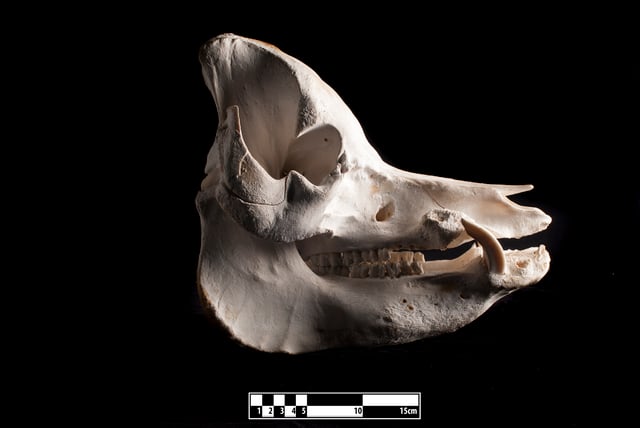
Skull of domestic pig.
A typical pig has a large head with a long snout that is strengthened by a special prenasal bone and by a disk of cartilage at the tip.[8] The snout is used to dig into the soil to find food and is a very acute sense organ. There are four hoofed toes on each foot, with the two larger central toes bearing most of the weight, but the outer two also being used in soft ground.[9]
The dental formula of adult pigs is 3.1.4.33.1.4.3, giving a total of 44 teeth. The rear teeth are adapted for crushing. In the male, the canine teeth form tusks, which grow continuously and are sharpened by constantly being ground against each other.[8]
Occasionally, captive mother pigs may savage their own piglets, often if they become severely stressed.[10] Some attacks on newborn piglets are non-fatal. Others may cause the death of the piglets and sometimes, the mother may eat the piglets. It is estimated that 50% of piglet fatalities are due to the mother attacking, or unintentionally crushing, the newborn pre-weaned animals.[11]
Distribution and evolution
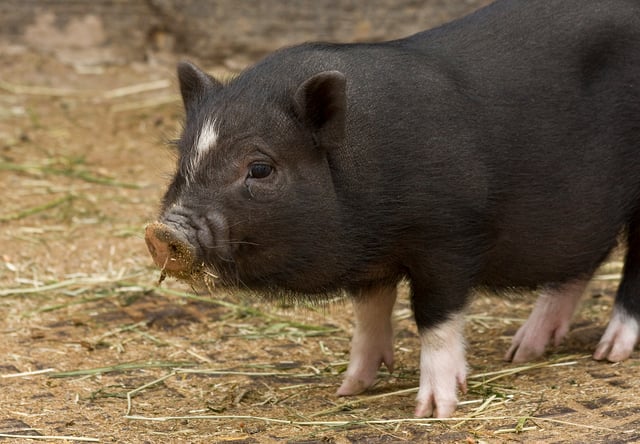

With around 1 billion individuals alive at any time, the domestic pig is one of the most numerous large mammals on the planet.[3][4]
Long isolated from other pigs on the many islands of Indonesia, Malaysia, and the Philippines, pigs have evolved into many different species, including wild boar, bearded pigs, and warty pigs.
Humans have introduced pigs into Australia, North and South America, and numerous islands, either accidentally as escaped domestic pigs which have gone feral, or as wild boar.
Habitat and reproduction
The wild pig (Sus scrofa) can take advantage of any forage resources. Therefore, it can live in virtually any productive habitat that can provide enough water to sustain large mammals such as pigs. If there is increased foraging of wild pigs in certain areas, it can cause a nutritional shortage which can cause the pig population to decrease. If the nutritional state returns to normal, the pig population will most likely rise due to the pigs' naturally increased reproduction rate.[12]
Diet and foraging
Pigs are omnivores, which means that they consume both plants and animals. In the wild, they are foraging animals, primarily eating leaves, roots, fruits, and flowers, in addition to some insects and fish. As livestock, pigs are fed mostly corn and soybean meal[13] with a mixture of vitamins and minerals added to the diet. Traditionally, they were raised on dairy farms and called "mortgage lifters", due to their ability to use the excess milk as well as whey from cheese and butter making combined with pasture.[14] Older pigs will consume three to five gallons of water per day.[15] When kept as pets, the optimal healthy diet consists mainly of a balanced diet of raw vegetables, although some may give their pigs conventional mini pig pellet feed.[16]
Relationship with humans
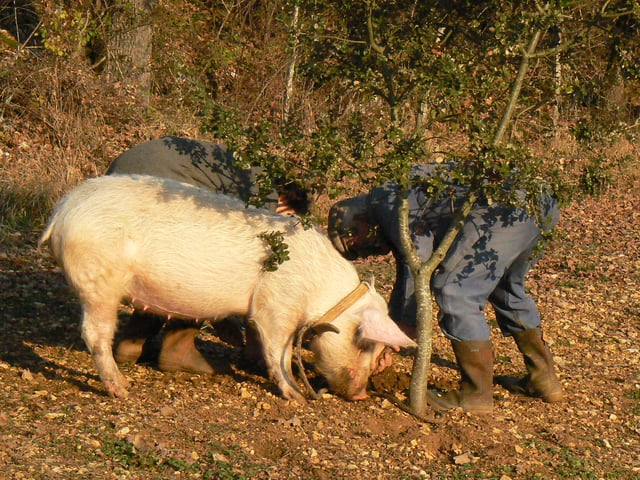
A pig trained to find truffles.
Domesticated pigs, especially miniature breeds, are commonly kept as pets.[17] Domestic pigs are raised commercially as livestock; materials that are garnered include their meat (known as pork), leather, and their bristly hairs which are used to make brushes. Because of their foraging abilities and excellent sense of smell, they are used to find truffles in many European countries. Both wild and feral pigs are commonly hunted.
The relatively short, stiff, coarse hairs of the pig are called bristles, and were once so commonly used in paintbrushes that in 1946 the Australian Government launched Operation Pig Bristle. In May 1946, in response to a shortage of pig bristles for paintbrushes to paint houses in the post-World War II construction boom, the Royal Australian Air Force (RAAF) flew in 28 short tons of pig bristles from China, their only commercially available source at the time.[18]
Use in human healthcare
Human skin is very similar to pig skin, therefore pig skin has been used in many preclinical studies.[19][20] In addition to providing use in biomedical research[21][19][20] and for drug testing,[22] genetic advances in human healthcare have provided a pathway for domestic pigs to become xenotransplantation candidates for humans.[23]
Species

Bearded pigs (Sus barbatus
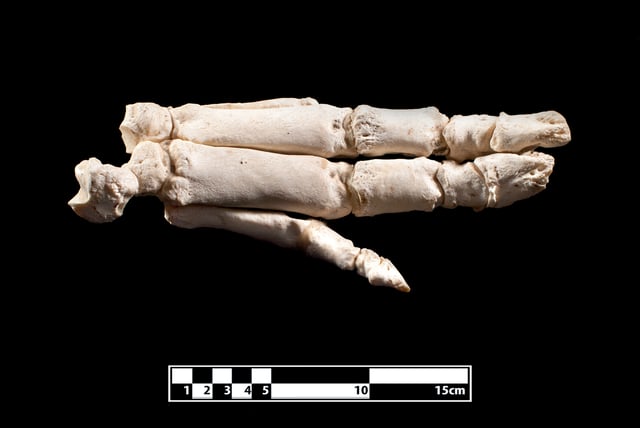
Skeleton of foot.
The genus Sus is currently thought to contain eight living species. A number of extinct species (†) are known from fossils.
Sus ahoenobarbus
†Sus australis Han, 1987 – Early Pleistocene of China
Sus barbatus
†Sus bijiashanensisHan* et al.*, 1975 – Early Pleistocene of China
†Sus bucculentus Heude, 1892 – Heude's pig or Indo-Chinese (or Vietnam) warty pig
Sus cebifrons
Sus celebensis
†Sus falconeri – Pleistocene of the Siwalik region, India
†Sus houiQi* et al.*, 1999 – Pleistocene of China
†Sus hysudricus Falconer and Cautley 1847 – Pliocene of India
†Sus jiaoshanensis Zhao, 1980 – Early Pleistocene of China
†Sus liuchengensis Han, 1987 – Early Pleistocene of China
†Sus lydekkeri Zdansky, 1928 – Pleistocene of China
†Sus officinalis Koenigswald, 1933 – Middle Pleistocene of China
Sus oliveri
†Sus peii Han, 1987 – Early Pleistocene of China
Sus philippensis
Sus scrofa – Wild boar Linnaeus, 1758 Sus scrofa domestica
†Sus subtriquetra Xue, 1981
†Sus strozzi Forsyth Major, 1881 - Pliocene and Early Pleistocene of Europe
Sus verrucosus
†Sus xiaozhuHan* et al.*, 1975 – Early Pleistocene of China
The pygmy hog, formerly Sus salvanius is now placed in the monotypic genus Porcula.[24]
Domestic pigs
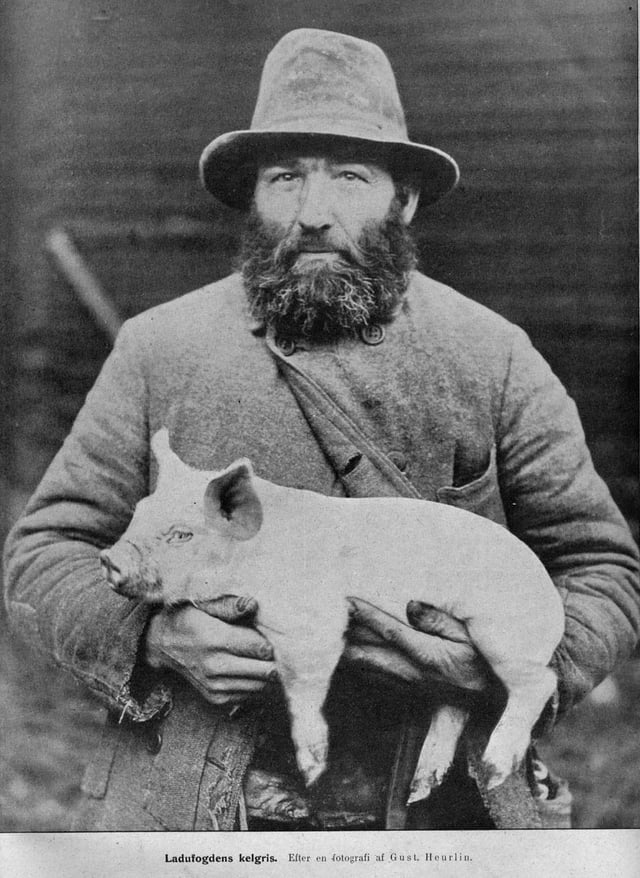
Swedish pig farmer with piglet.
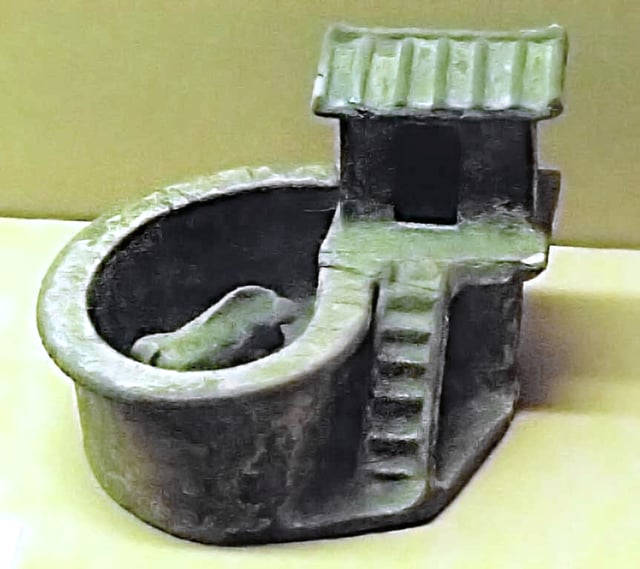
Green glazed toilet with pigsty model.
Pigs have been domesticated since ancient times in the Old World. Archaeological evidence suggests that pigs were being managed in the wild in a way similar to the way they are managed by some modern New Guineans from wild boar as early as 13,000–12,700 BP in the Near East in the Tigris Basin,[25] Çayönü, Cafer Höyük, Nevalı Çori.[26] Remains of pigs have been dated to earlier than 11,400 BP in Cyprus that must have been introduced from the mainland which suggests domestication in the adjacent mainland by then.[27] A separate domestication also occurred in China.[28]
In India, pigs have been domesticated for a long time mostly in Goa and some rural areas for pig toilets. This was also done in China. Though ecologically logical as well as economical, pig toilets are waning in popularity as use of septic tanks and/or sewerage systems is increasing in rural areas.
Pigs were brought to southeastern North America from Europe by Hernando de Soto and other early Spanish explorers. Pigs are particularly valued in China and on certain oceanic islands, where their self-sufficiency allows them to be turned loose, although the practice is not without its drawbacks (see environmental impact).
The domestic pig (Sus scrofa domesticus) is usually given the scientific name Sus scrofa, although some taxonomists call it S. domesticus, reserving S. scrofa for the wild boar. It was domesticated approximately 5,000 to 7,000 years ago. The upper canines form sharp distinctive tusks that curve outward and upward. Compared to other artiodactyles, their head is relatively long, pointed, and free of warts. Their head and body length ranges from 0.9 to 1.8 m (35 to 71 in) and they can weigh between 50 and 350 kg (110 and 770 lb).
In November 2012, scientists managed to sequence the genome of the domestic pig. The similarities between the pig and human genomes mean that the new data may have wide applications in the study and treatment of human genetic diseases.[29][30][31]
In August 2015, a study looked at over 100 pig genome sequences to ascertain their process of domestication.
The process of domestication was assumed to have been initiated by humans, involved few individuals and relied on reproductive isolation between wild and domestic forms.
The study found that the assumption of reproductive isolation with population bottlenecks was not supported.
The study indicated that pigs were domesticated separately in Western Asia and China, with Western Asian pigs introduced into Europe where they crossed with wild boar.
A model that fitted the data included admixture with a now extinct ghost population of wild pigs during the Pleistocene. The study also found that despite back-crossing with wild pigs, the genomes of domestic pigs have strong signatures of selection at DNA loci that affect behavior and morphology. The study concluded that human selection for domestic traits likely counteracted the homogenizing effect of gene flow from wild boars and created domestication islands in the genome. The same process may also apply to other domesticated animals.[32] [33]
Cultural and religious reference to pigs
Pigs appear in the traditional and popular arts, media, and cultures of many societies, where they sometimes carry religious symbolism. In Asia the wild boar is one of 12 animal images comprising the Chinese zodiac, while in Europe the boar represents a standard charge in heraldry. In Islam and Judaism pigs and those who handle them are viewed negatively, and the consumption of pork is forbidden. Epicureans consider the pig as an official mascot or totem, and bronze sculptures of pigs have been found in the Epicurean library at Herculaneum. Pigs are frequently alluded to in folk art, idioms, metaphors, and proverbs, and also occasionally in parables (e.g. Parable of the Prodigal Son).
In folklore, folkways, and mythology
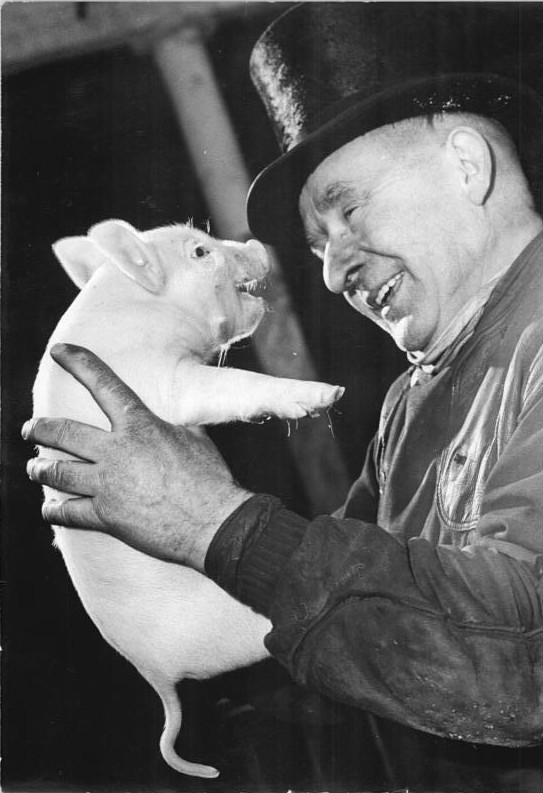
Pig at a German new year event, 1965.
In European folklore, there is a widespread belief that pigs are intensely frightened by mirrors.
In many European countries, a feast has formed around slaughtering a pig.
In Germany, pigs are known as a symbol for good luck. Marzipan pigs are a popular confectionery, especially as a gift on New Year's Eve.
Superstitious sailors consider pigs to be unlucky because they have cloven hooves like the Devil and are terrified of water.[34] Pigs would not be carried on boats. Fishermen once regarded pigs as harbingers of bad luck: a fisherman seeing a pig on his way to work would rather turn round and go home. This even extended to a prohibition of the word "pig" on board a vessel. This is why the animals were referred to, across North East England, as "gissies".
In religion
In ancient Egypt, pigs were associated with Set, the rival to the sun god Horus. When Set fell into disfavour with the Egyptians, swineherds were forbidden to enter temples. According to Herodotus, swineherds were a kind of separate sect or caste, which only married among themselves. Egyptians regarded pigs as unworthy sacrifices to their gods other than the Moon and Dionysus, to whom pigs were offered on the day of the full Moon. Herodotus states that, though he knew the reason why Egyptians abominated swine at their other feasts but they sacrificed them at this one; however, it was to him "not a seemly one for me to tell".[35]
In ancient Greece, a sow was an appropriate sacrifice to Demeter and had been her favorite animal since archaic times. Initiates at the Eleusinian Mysteries began by sacrificing a pig. Pig were also sacrificed to Aphrodite.
The ancient Romans practiced a sacrifice called the suovetaurilia, in which a pig, a ram, and a bull were sacrificed, as one of the most solemn acts of the Roman religion.
In Buddhism the deity Marici is often depicted riding in a carriage hauled by several pigs.
The Celts had a god of swine called Moccus, who under Roman occupation was identified with Mercury. In Celtic mythology, a cauldron overflowing with cooked pork was one of the attributes of The Dagda.
In the Chinese zodiac, the Pig is one of the 12-year cycle of animals. Believers in Chinese astrology associate each animal with certain personality traits (see: Pig (zodiac)).
In Christianity the book of Mark, in an event referred to as the exorcism of the Gerasene demoniac Jesus casts the demons Legion (demon) possessing a swine herder from Gerasene; into 2000 of the swine herders pigs.[36]
In Haitian Vodou, Ezili Dantor, the lwa of motherhood, is associated with the black Creole Pig of Haiti, her favorite animal sacrifice.
In Hinduism the god Vishnu took the form of a four-armed humanoid with the head of a boar named Varaha in order to save the Earth from a demon who had dragged it to the bottom of the sea.
In Islam the eating of pork is also sinful (see Haraam). The Qur'an prohibits the consumption of pork in no less than 4 different places. It is prohibited in 2:173, 5:3, 6:145 and 16:115. "Forbidden to you (for food) are: dead meat, blood, the flesh of swine, and that on which hath been invoked the name of other than Allah." [Al-Qur'an 5:3] Islam treats pigs as inedible animals par excellence, the animal that is central to the concepts of haram
The dietary laws of Judaism (Kashrut) forbid, among other kinds of meat, the eating of pork in any form, considering the pig to be an unclean animal as food (see taboo food and drink). Pork is as forbidden as the meat of any other unclean animal, but probably due to extensive use of pork in modern days, abhorrence of pork is far stronger and emotional in traditional Jewish culture than that of other forbidden foods. Many Ancient Jews also held the prohibition on pigs above other taboos. In De Specialibus Legibus, Philo of Alexandria, a first-century Jewish writer, relates that pigs were lazy scavengers, the embodiment of vice. Philo also argued that since pigs will eat the flesh of human corpses, that men should abstain from eating them so as not to be contaminated.[37]
In Nordic Mythology, "Gold-Bristle" or "Gold-Mane" was Freyr's golden boar, created by the dwarves Brokk and Sindri as part of a challenge. His shining fur is said to fill the sky, trees, and sea with light.
Among Seventh-day Adventists and some other denominations, the eating of pork is prohibited. Most Christians believe that the eating of pork is not prohibited, according to the teachings of the New Testament. In Catholicism, Eastern Orthodoxy, and other, older Christian groups, pigs are associated with Saint Anthony the Great, who is known as the patron saint of swineherds.
Environmental impacts

Feral pigs (razorbacks) in Florida
Domestic pigs that have escaped from urban areas or were allowed to forage in the wild, and in some cases wild boars which were introduced as prey for hunting, have given rise to large populations of feral pigs in North and South America, Australia, New Zealand, Hawaii, and other areas where pigs are not native.
Accidental or deliberate releases of pigs into countries or environments where they are an alien species have caused extensive environmental change. Their omnivorous diet, aggressive behaviour, and their feeding method of rooting in the ground all combine to severely alter ecosystems unused to pigs. Pigs will even eat small animals and destroy nests of ground nesting birds.[8] The Invasive Species Specialist Group lists feral pigs on the list of the world's 100 worst invasive species and says:[38]
Feral pigs like other introduced mammals are major drivers of extinction and ecosystem change.
They have been introduced into many parts of the world, and will damage crops and home gardens as well as potentially spreading disease.
They uproot large areas of land, eliminating native vegetation and spreading weeds.
This results in habitat alteration, a change in plant succession and composition and a decrease in native fauna dependent on the original habitat.
Health issues
Because of the biological similarities between each other, pigs can harbour a range of parasites and diseases that can be transmitted to humans. These include trichinosis, Taenia solium, cysticercosis, and brucellosis. Pigs are also known to host large concentrations of parasitic ascarid worms in their digestive tract.[39]
Some strains of influenza are endemic in pigs. Pigs also can acquire human influenza.
See also
Wild boar
Miniature pig
Peccary (domestication)
Truffle hog
Pot-bellied pig
Babirusa
Red river hog
Bushpig
Fetal pig
Hog-baiting
List of fictional pigs
List of pigs
Pig Olympics
Enviropig
Pig Beach